Services we offer
Find out how we can help you
At Connexions we offer a broad range of psychological services.
These include treatment for mood disorders, such as depression and bipolar disorder, anxiety disorders which may present in the form of generalised anxiety, panic disorder, social anxiety, obsessive compulsive disorder, post traumatic stress disorder and / or phobia. More complex presentations, such as trauma and personality disorders, are also an area of treatment that all the psychologists at LifeConnexions are experienced with.


Anxiety Disorders
Anxiety Disorders and their treatment
Anxiety disorder is a blanket term covering several different forms of anxieties, fears and phobias. These include Generalised Anxiety Disorder better known as excessive worry, Obsessive-Compulsive Disorder, Panic Disorder, Post Traumatic Stress Disorder, Social Anxiety and Specific Phobias.
Distinguishing among different anxiety disorders is important, since accurate diagnosis is more likely to result in effective treatment and a better prognosis. Surveys have shown as many as 30% of Australians may be affected by anxiety disorders.
Luckily the psychological treatment for anxiety disorders is very effective. A combination of education, relaxation / meditation and exposure therapy has been found to work very well in assisting people in the treatment of anxiety. The gradual exposure approach, that is developed in conjunction with the client, enables them to change their relationship with their thoughts and feelings about their fear resulting in better coping and improved quality of life.
Anxiety disorders are frequently accompanied by physiological symptoms that may lead to fatigue or even exhaustion. Clinical depression often accompanies many persistent or poorly treated anxiety disorders. For this reason a thorough assessment is crucial to effective treatment outcomes.
Generalised Anxiety Disorder
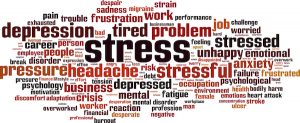 If you struggle with Generalised Anxiety Disorder (GAD) you will have obsessive worry about all manner of things in your life and it will interfere with your daily functioning. You will typically anticipate disaster, and are overly concerned about everyday matters such as your health, financial concerns, death, family and or friendship problems as well as interpersonal and or work relationship. You will often experience a variety of physical symptoms, including restlessness, fidgeting, fatigue, headaches, nausea, numbness or tingling in hands and feet, muscle tension, muscle aches, difficulty swallowing, excessive stomach acid buildup, stomach pain, vomiting, diarrhea, bouts of breathing difficulty, difficulty concentrating, trembling, twitching, irritability, agitation, sweating, insomnia, hot flashes, rashes, and inability to fully control the anxiety (ICD-10).
If you struggle with Generalised Anxiety Disorder (GAD) you will have obsessive worry about all manner of things in your life and it will interfere with your daily functioning. You will typically anticipate disaster, and are overly concerned about everyday matters such as your health, financial concerns, death, family and or friendship problems as well as interpersonal and or work relationship. You will often experience a variety of physical symptoms, including restlessness, fidgeting, fatigue, headaches, nausea, numbness or tingling in hands and feet, muscle tension, muscle aches, difficulty swallowing, excessive stomach acid buildup, stomach pain, vomiting, diarrhea, bouts of breathing difficulty, difficulty concentrating, trembling, twitching, irritability, agitation, sweating, insomnia, hot flashes, rashes, and inability to fully control the anxiety (ICD-10).
Two types of worry are identified in understanding GAD. Everyday worry that most of us will experience. This is type 1 worry. Type 2 worry is where you may convince yourself that if you dont worry something bad will happen. This often characterised by worrying about worrying. For example, in type 1 worry your partner is late home from work driving from Sydney and you wonder where they may be. In contrast with type 2 worry, you will initially wonder why they are late and then create a negative worry story about “what if” they have had a car accident and run off the road and no one knows that they are hurt, and if they are not found in the next 2 hours then ……….
As you can see this is very distressing and can be exhausting as this pattern requires huge amounts of energy and often impacts on people’s daily life, ability to cope as well as energy levels and sleep patterns.
In our initial assessment we can determine what your needs are and how we introduce the most appropriate treatment option for you. So if you relate to many of the patterns identified above consider seeing your GP for a referral. GAD often works well with either a CBT or ACT approach. For more information see Our Approach and if you feel that we can be of support give us a call and make an appointment.
Obsessive Compulsive Disorder
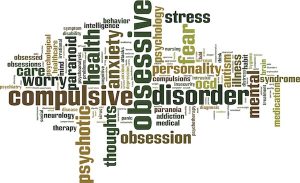 If you experience Obsessive Compulsive Disorder (OCD) you will likely recognise it can be quite a significant challenge to manage. Clearly the severity and intensity of OCD varies between each person. Some may suffer mild to moderate symptoms that effect their ability to complete normal activities in their day in a timely manner. Others in contrast maybe debilitated so much that they are unable to work due to the suffering they experience. Our psychologists will look for three important factors in working with an OCD sufferer: firstly are there obsessional thoughts, secondly do compulsions follow these thoughts as a neutralising effect in some ritualised repetitive pattern and finally does the interaction between the obsessive and compulsive cycle take alot of time, and impact on the opportunity for the sufferer to participate in valued based activity, such as spending time with friends and family, completing fun and enjoyable things in their life and or being able to complete everyday tasks without the person becoming intensely overwhelmed.
If you experience Obsessive Compulsive Disorder (OCD) you will likely recognise it can be quite a significant challenge to manage. Clearly the severity and intensity of OCD varies between each person. Some may suffer mild to moderate symptoms that effect their ability to complete normal activities in their day in a timely manner. Others in contrast maybe debilitated so much that they are unable to work due to the suffering they experience. Our psychologists will look for three important factors in working with an OCD sufferer: firstly are there obsessional thoughts, secondly do compulsions follow these thoughts as a neutralising effect in some ritualised repetitive pattern and finally does the interaction between the obsessive and compulsive cycle take alot of time, and impact on the opportunity for the sufferer to participate in valued based activity, such as spending time with friends and family, completing fun and enjoyable things in their life and or being able to complete everyday tasks without the person becoming intensely overwhelmed.
The more common ritualised compulsions are cleaning, organising, hand and or body washing, checking (doors and locks for example) and counting of things. Often this will take more than a hour of the person’s day. They usually realise that what they are doing does not make sense and if they could change it they would. But the levels of distress and anxiety becomes so overwheleming that they remain trapped in the OCD cycle. Importantly some people may not have observable compulsive behaviours but rather it may all occur within the person’s head. For example with counting. It may not be possible to see the person’s outward struggle, as it all happens within the confines of their mind.
In our initial assessment we can determine what your needs are and how we introduce the most appropriate treatment option for you. So if you relate to many of the patterns identified above consider seeing your GP for a referral. OCD often works well with either a CBT or ACT approach. For more information see Our Approach and if you feel that we can be of support give us a call and make an appointment.
Panic Disorder
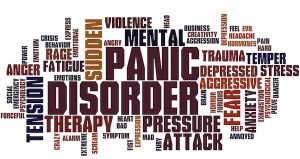 Panic Disorder word cloud concept on white background.[/caption]The term Panic disorder describes the development of recurrent feared and disabling panic attacks. It is most often characterised by repeated, unexpected and untriggered panic attacks. The person will worry and negatively anticipate for at least a month following the last panic attack fearing another attack is imminent. The worry associated with fear another attack usually revolves around the thought that some more severe medical problem has been undiagnosed – such as a heart problem. Some will pursue lengthy medical testing to assure themselves that something more sinister is not causing their physical symptoms. The continued fear of another panic attack then results in changes on behaviours that reinforce avoidance of any possible triggering of the physical symptoms. These symptoms commonly include : rapid heart rate, tightness in the chest, dizziness or light headedness, tingling in the hands and fingers, nausea, confusion, feelings of being physically disconnected, feelings of choking, difficulty breathing and increased perspiration.
Panic Disorder word cloud concept on white background.[/caption]The term Panic disorder describes the development of recurrent feared and disabling panic attacks. It is most often characterised by repeated, unexpected and untriggered panic attacks. The person will worry and negatively anticipate for at least a month following the last panic attack fearing another attack is imminent. The worry associated with fear another attack usually revolves around the thought that some more severe medical problem has been undiagnosed – such as a heart problem. Some will pursue lengthy medical testing to assure themselves that something more sinister is not causing their physical symptoms. The continued fear of another panic attack then results in changes on behaviours that reinforce avoidance of any possible triggering of the physical symptoms. These symptoms commonly include : rapid heart rate, tightness in the chest, dizziness or light headedness, tingling in the hands and fingers, nausea, confusion, feelings of being physically disconnected, feelings of choking, difficulty breathing and increased perspiration.
With a panic attack many of these symptoms appear. They can generally peak within the first 10 minutes but can last for upwards of an hour. The sufferer is often left feeling distressed and exhausted. This can be repeated several times a day at its worst. Having a panic attack in a single or even repeated incident does not mean a person has panic disorder.
During a panic attack, you’re suddenly overwhelmed by the physical sensations described above. Panic attacks reach a peak within about 10 minutes and usually last for up to half an hour, leaving you feeling tired or exhausted. They can occur several times a day or may happen only once every few years. They can even occur while people are asleep, waking them up during the attack. Many people experience a panic attack once or twice in their lives; this is common and is not panic disorder.
In our initial assessment we can determine what your needs are and how we introduce the most appropriate treatment option for you. So if you relate to many of the patterns identified above consider seeing your GP for a referral. Panic disorder works best with a CBT approach. For more information see Our Approach and if you feel that we can be of support give us a call and make an appointment.
PTSD
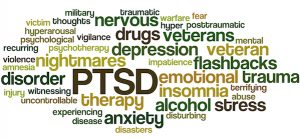 PTSD occurs when a person has experienced some form of, generally intense, trauma. This trauma could be caused by a variety of circumstances such as a motor vehicle accident or other serious accident physical or sexual assault or abuse, or a specific traumatic event in your life that has threatened your or others lives or safety.
PTSD occurs when a person has experienced some form of, generally intense, trauma. This trauma could be caused by a variety of circumstances such as a motor vehicle accident or other serious accident physical or sexual assault or abuse, or a specific traumatic event in your life that has threatened your or others lives or safety.
As a consequence of the intense helplessness, fear and distress the sufferer can develop symptoms that commonly include nightmares, intrusive thoughts and memories, depression, anxiety, feelings of being disconnected, agitation, low self-worth, and challenges with living in their daily life.
In our initial assessment we can determine what your needs are and how we introduce the most appropriate treatment option for you. So if you relate to many of the patterns identified above consider seeing your GP for a referral. PTSD often works well with either an CBT and / or ACT approach, but with more complex or chronic trauma, treatments such as EMDR and or Schema Therapy can be more effective and appropriate. For more information see Our Approach and if you feel that we can be of support give us a call and make an appointment.
Social Anxiety
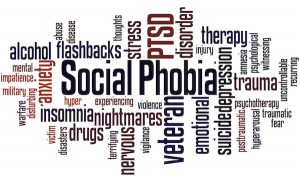 Social Anxiety can be a common experience for many people in daily life, and is often experienced in situations where some form of perceived judgement from others may be felt. A person may fear being criticised, negatively judged, laughed at or humiliated, even in everyday circumstances. Examples such as speaking in front of groups, a meal out with friends, presenting at school, work or at university, going to unfamiliar social environments or even where there are larger numbers of people. Similar to the other anxiety disorders listed under Services the symptoms can include blushing, excessive perspiration, trembling / shaking, stuttering with speech, or for some, nausea and / or diarrhoea.
Social Anxiety can be a common experience for many people in daily life, and is often experienced in situations where some form of perceived judgement from others may be felt. A person may fear being criticised, negatively judged, laughed at or humiliated, even in everyday circumstances. Examples such as speaking in front of groups, a meal out with friends, presenting at school, work or at university, going to unfamiliar social environments or even where there are larger numbers of people. Similar to the other anxiety disorders listed under Services the symptoms can include blushing, excessive perspiration, trembling / shaking, stuttering with speech, or for some, nausea and / or diarrhoea.
A combination of education, relaxation / meditation and exposure therapy has been found to work very well in assisting people in the treatment of social anxiety. The gradual exposure approach, that is developed in conjunction with the client, enables them to change their relationship with their thoughts and feelings about their fear of social situations resulting in better coping and improved quality of life.
Specific Phobias
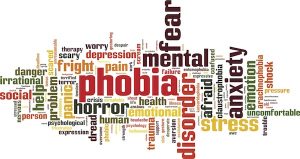 The term Specific Phobias relates to an excessive and often irrational fear and response to specific environments, objects or things. The more common types of phobia include fear of small places, heights, lightning or storms, the dark, medical procedures including needles, spiders, flying, blood, animals – including dogs, cats, snakes, rats, mice, birds. There are even more specific and less common forms of phobias that may occur for people.
The term Specific Phobias relates to an excessive and often irrational fear and response to specific environments, objects or things. The more common types of phobia include fear of small places, heights, lightning or storms, the dark, medical procedures including needles, spiders, flying, blood, animals – including dogs, cats, snakes, rats, mice, birds. There are even more specific and less common forms of phobias that may occur for people.
Phobias can be debilitating for those experiencing the distress associated with the trigger and fear of being exposed. The effort that may go into preventing the risk exposure can become problematic for the sufferer requiring treatment.
A combination of education, relaxation / meditation and exposure therapy has been found to work very well in assisting people in the treatment of specific phobias. The gradual exposure approach, that is developed in conjunction with the client, enables them to change their relationship with their thoughts and feelings about their fear resulting in better coping and improved quality of life.
Chronic Pain and Disability Adjustment
Chronic Pain and Disability Adjustment
At LifeConnexions we are specialists in the treatment of chronic pain and the difficulties associated with the ongoing treatment and management of this very challenging problem occuring for many people in today’s society.
Pain can be classified as either “acute” or “chronic”. Acute pain is the most common reason why patients seek medical attention. Acute pain usually has a sudden onset and is associated with tissue damage or painful stimuli (e.g., headache, skinned knee, muscle aches, labor pain). Acute pain is often adaptive because it alerts us to the presence and location of tissue injury and corrects behavior that may be causing or contributing to it. It also reminds us when an injured body part, such as a back or knee, needs time to heal.
Chronic pain, on the other hand, refers to the continuation of pain for greater than three months despite treatment and coping efforts by the individual. It has no protective role and is not necessarily associated with tissue damage as viewed from imaging techniques such as MRI or X-ray. Chronic pain can impact all areas of a person’s life and is often associated with functional, psychological and social problems. In addition, chronic pain can have a significant impact on a person’s family and friends.
From a treatment perspective a combination of psycho-education, relaxation / mindfulness meditation, increasing functional activity balanced with pacing has been found to work very well in assisting people in the management of, and coping with chronic pain. The gradual increase in appropriate values based activity, enables the sufferer to change their relationship with their thoughts and feelings about their pain and symptoms resulting in better coping and improved quality of life.


Chronic Pain and Disability Adjustment
Chronic Pain and Disability Adjustment
At LifeConnexions we are specialists in the treatment of chronic pain and the difficulties associated with the ongoing treatment and management of this very challenging problem occuring for many people in today’s society.
Pain can be classified as either “acute” or “chronic”. Acute pain is the most common reason why patients seek medical attention. Acute pain usually has a sudden onset and is associated with tissue damage or painful stimuli (e.g., headache, skinned knee, muscle aches, labor pain). Acute pain is often adaptive because it alerts us to the presence and location of tissue injury and corrects behavior that may be causing or contributing to it. It also reminds us when an injured body part, such as a back or knee, needs time to heal.
Chronic pain, on the other hand, refers to the continuation of pain for greater than three months despite treatment and coping efforts by the individual. It has no protective role and is not necessarily associated with tissue damage as viewed from imaging techniques such as MRI or X-ray. Chronic pain can impact all areas of a person’s life and is often associated with functional, psychological and social problems. In addition, chronic pain can have a significant impact on a person’s family and friends.
From a treatment perspective a combination of psycho-education, relaxation / mindfulness meditation, increasing functional activity balanced with pacing has been found to work very well in assisting people in the management of, and coping with chronic pain. The gradual increase in appropriate values based activity, enables the sufferer to change their relationship with their thoughts and feelings about their pain and symptoms resulting in better coping and improved quality of life.

Mood Disorders including Depression
Mood Disorders including Depression
Negative emotions are normal parts of our day to day life. When these emotions and negative patterns of thinking become persistent and cause us to become sad most of the time, have periods of agitation and irritability, have ongoing feelings of guilt, loss of interest in people of things, a sense of failure and or regret; then depression may be having a significant impact on the person’s life. These changes can prevent an individual from functioning in a healthy and joyful manner. It ranges from those that may be a little down through to major depression, and may include those that can suffer from bipolar disorder. In bipolar disorder the person experiences high highs and low lows. These are described as distinct episodes of mania as well as depression.
Importantly however, feeling sadness in your life does not mean that a person in “depressed” it simply means they are sad. For most people this will pass and their mood will pick up within a short period of time. From a treatment perspective there are a number of effective paths to consider. Certainly CBT and ACT (see Our Approach) have a proven benefit in changing the relationship between negative patterns of thought and emotions to create more functional patterns of behaviour.
As with many of the struggles that our client’s present with there are those that suffer with more chronic and deep patterns of depression. These can be resistant to the standard treatment approaches related to CBT. For this reason our psychologists work with emotion focused psychotherapies such as Interpersonal Psychotherapy, Emotion Focused Psychotherapy and Schema Therapy for those that are suffering more chronic patterns of of depression.

Mood Disorders including Depression
Mood Disorders including Depression
Negative emotions are normal parts of our day to day life. When these emotions and negative patterns of thinking become persistent and cause us to become sad most of the time, have periods of agitation and irritability, have ongoing feelings of guilt, loss of interest in people of things, a sense of failure and or regret; then depression may be having a significant impact on the person’s life. These changes can prevent an individual from functioning in a healthy and joyful manner. It ranges from those that may be a little down through to major depression, and may include those that can suffer from bipolar disorder. In bipolar disorder the person experiences high highs and low lows. These are described as distinct episodes of mania as well as depression.
Importantly however, feeling sadness in your life does not mean that a person in “depressed” it simply means they are sad. For most people this will pass and their mood will pick up within a short period of time. From a treatment perspective there are a number of effective paths to consider. Certainly CBT and ACT (see Our Approach) have a proven benefit in changing the relationship between negative patterns of thought and emotions to create more functional patterns of behaviour.
As with many of the struggles that our client’s present with there are those that suffer with more chronic and deep patterns of depression. These can be resistant to the standard treatment approaches related to CBT. For this reason our psychologists work with emotion focused psychotherapies such as Interpersonal Psychotherapy, Emotion Focused Psychotherapy and Schema Therapy for those that are suffering more chronic patterns of of depression.
Personality Disorders
Personality Disorders
Formerly referred to as Character Disorders, Personality Disorders are a group of disorders characterised by rigid and on-going patterns of feeling, thinking, and behaviour. The underlying beliefs that form these patterns are referred to as “maladaptive schemas”. The inflexibility and pervasiveness of these behavioural patterns often cause serious personal and social difficulties, as well as a general functional impairment.
Personality disorders are defined as “an enduring pattern of inner experience and behaviour that deviates markedly from the expectations of the culture of the individual who exhibits it”. The onset of these patterns of behaviour can typically be traced back to adolescence and childhood.
At LifeConnexions each of our therapists are trained and experienced in Schema Therapy. Please go to this section in Our Approach for further information.

Have a questions or Need to make an Appointment? Email Us!

Copyright @ 2024 Life Connexions Wollongong. All Rights Reserved.
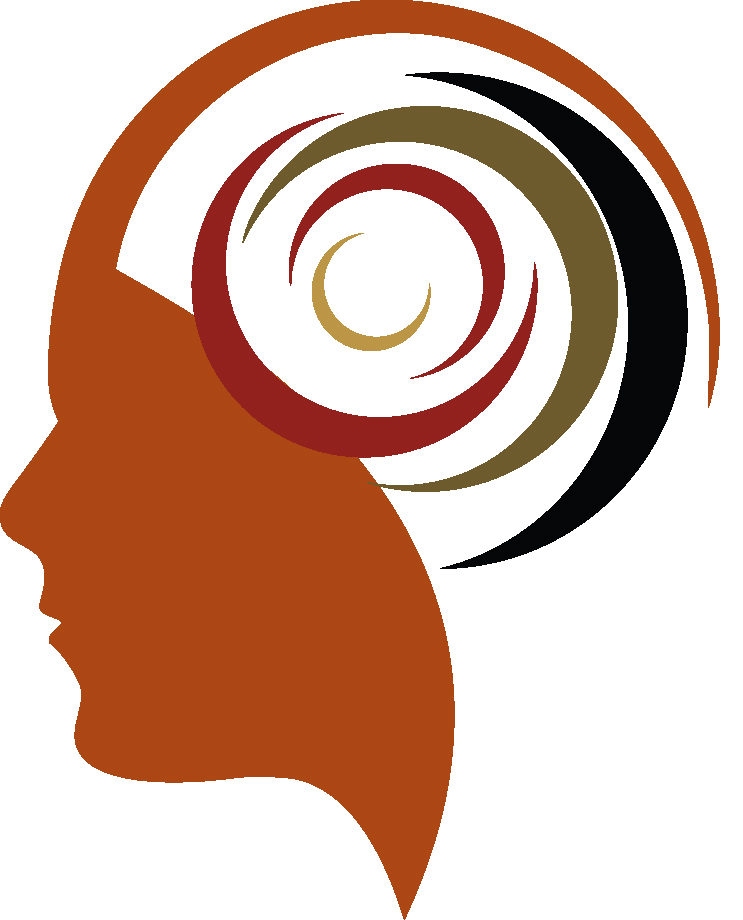

 For many leaders, managers and professionals in the work and business sector the demands of achieving key performance indicators can result in significant stress and negative impacts on the individual. At LifeConnexions we have psychologists qualified and experienced in organisational psychology, as well as understanding the need for a balance between people and real business outcomes.
For many leaders, managers and professionals in the work and business sector the demands of achieving key performance indicators can result in significant stress and negative impacts on the individual. At LifeConnexions we have psychologists qualified and experienced in organisational psychology, as well as understanding the need for a balance between people and real business outcomes.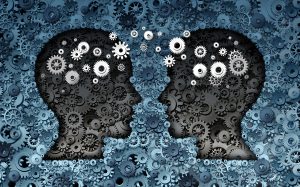 In today’s world of fast paced intensity, LifeConnexion’s Organisational Psychology service can assist with maximising performance outcomes while managing the needs of the individual and the team.
In today’s world of fast paced intensity, LifeConnexion’s Organisational Psychology service can assist with maximising performance outcomes while managing the needs of the individual and the team.